Your watch mistracks downhill elevation loss because it relies on barometric pressure sensors and GPS triangulation, both of which have significant limitations. Barometric sensors drift over time and react to weather changes, while GPS has vertical accuracy errors of ±45 meters compared to just ±15 meters horizontally. Smoothing algorithms also underestimate steep descents, and environmental factors like dense foliage or buildings obstruct satellite signals. Understanding these technical challenges reveals why your elevation data often disappoints.
Barometric Pressure Sensors Vs GPS Triangulation Accuracy
When you’re tracking elevation changes on your watch, you’re relying on one of two primary technologies: barometric pressure sensors or GPS triangulation.
Barometric sensors measure ambient air pressure through MEMS technology, converting readings to altitude using standard atmosphere models. They react quickly to elevation changes, providing smooth altitude profiles during rapid descents.
MEMS barometric sensors deliver real-time altitude tracking by converting air pressure changes into precise elevation data during dynamic terrain navigation.
GPS calculates altitude through satellite triangulation relative to a reference ellipsoid. However, it updates less frequently and suffers from larger vertical errors—typically ±45 meters compared to ±15 meters horizontally. GPS requires signals from a minimum of four satellites for accurate 3D location positioning.
During steep downhill movement, GPS readings lag behind actual changes, creating smoothed curves that don’t capture real-time elevation loss.
Barometric sensors excel at tracking immediate altitude changes, while GPS provides more stable long-term references despite slower response times.
Data Logging Frequency and Sampling Rate Impact
Your watch’s data logging frequency—how often it records GPS points—directly determines how much elevation loss it captures during your activities. When devices sample GPS data every few seconds instead of every second, they miss subtle terrain changes that contribute to total descent.
Higher sampling rates provide more detailed tracking on downhill sections, while lower frequencies create gaps where elevation changes go unrecorded. Complex terrain like mountains requires frequent logging to maintain accuracy, as +/- 10m GPS elevation tolerance compounds with sparse data points.
Smart Recording captures data only when significant changes occur in direction, speed, or elevation, which can result in missed elevation variations during gradual descents. This space-efficient approach prioritizes battery life over comprehensive tracking detail.
| Device Feature | Impact on Elevation Loss |
|---|---|
| Every Second Recording | Captures detailed descent changes |
| 5-Second Intervals | Misses subtle elevation variations |
| Terrain-Based Adjustment | Optimizes accuracy for conditions |
| Custom Data Fields | Prioritizes elevation metrics |
| High Sampling Rates | Reduces measurement discrepancies |
Different devices offer varying logging capabilities—Garmin’s “Every Second Recording” and COROS’s customizable data fields help minimize tracking errors.
Weather Changes and Atmospheric Interference
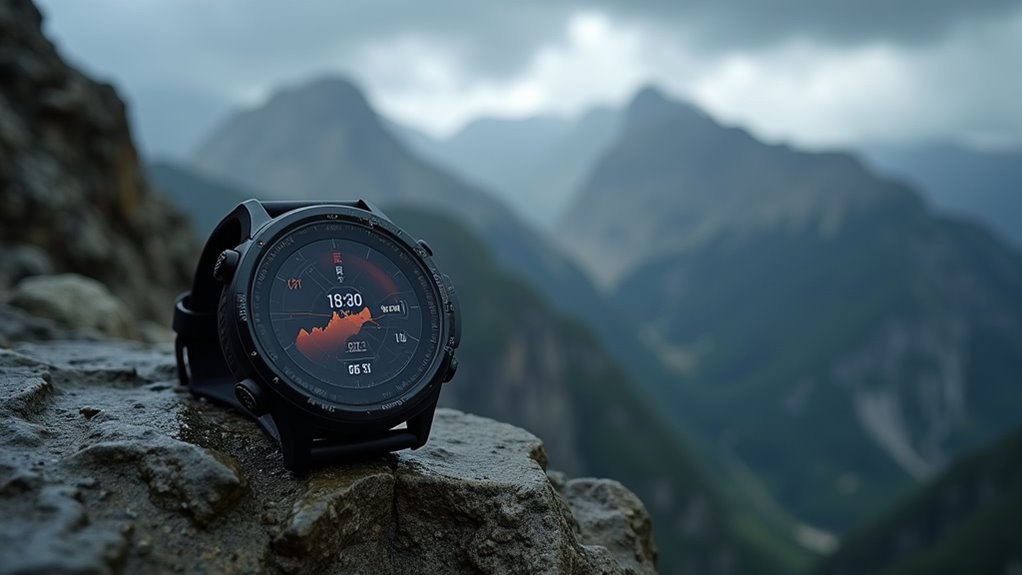
Beyond your watch’s internal sampling settings, atmospheric conditions create another layer of complexity that affects elevation tracking accuracy.
Weather changes alter how GPS signals travel through the atmosphere, causing delays that throw off your watch’s calculations.
When you’re hiking during weather fronts or temperature fluctuations, your watch receives signals that’ve been slowed by ionospheric and tropospheric interference. High humidity, changing air pressure, and precipitation weaken GPS signals, while solar activity can disrupt them entirely.
Signals traveling through more atmosphere—like when satellites are near the horizon—experience greater delays.
Your watch compensates using dual-frequency GPS and mathematical models, but sudden weather changes can still cause temporary elevation errors. The ionospheric delay depends on frequency and can be corrected using multiple frequency bands.
This explains why you might notice discrepancies during storms or rapidly changing conditions.
Device Calibration Drift Over Time
Your watch’s barometric sensor gradually drifts from its original calibration point, causing elevation readings to become increasingly inaccurate over time.
This drift occurs naturally as the sensor’s components age and respond differently to pressure changes than when first manufactured. Manual recalibration using GPS may provide temporary accuracy, but the sensor typically begins showing incorrect values again within approximately 24 hours.
Even watches with auto-calibration features can’t always compensate for this drift, especially when the automatic adjustments themselves introduce errors or fail to account for rapid environmental changes.
Barometric Sensor Drift
Although your smartwatch’s barometric sensor starts with factory precision, it won’t maintain that accuracy indefinitely.
Weather fluctuations cause the most dramatic drift – storms and changing air masses create sudden pressure shifts that throw off your device’s calibration. Daily pressure variations and humidity changes gradually alter your elevation baseline, even in stable conditions.
Temperature variability affects air density, influencing how your watch interprets pressure readings.
Over time, device aging and moisture exposure degrade sensor performance further. Without regular calibration, these factors accumulate into significant errors.
You’ll notice drift through inconsistent elevation data between similar routes or wildly inaccurate starting altitudes at familiar locations. Environmental factors like rapid air movement can also interfere with proper sensor function during activities.
Your watch might record phantom elevation gains at your house or miss legitimate climbs during activities, making fitness tracking unreliable.
Auto-Calibration Limitations
Even when your smartwatch features auto-calibration technology, this automated system can’t completely solve elevation tracking problems. Your device’s internal calibration degrades over time due to sensor aging and firmware updates, creating performance drift that develops gradually over weeks or months.
Several factors limit auto-calibration effectiveness:
- GPS signal interference from urban canyons or heavy tree cover reduces calibration accuracy.
- Weather conditions like rain, humidity, and storms impact sensor readings during recalibration cycles.
- Environmental extremes and variable conditions cause drift errors to accumulate more noticeably.
- Device wear from mechanical stress and battery degradation subtly affects sensor stability.
While auto-calibration mitigates some drift, it can’t eliminate systematic errors entirely, leading to persistent elevation misreadings during your activities. Many users discover that manual calibration at known elevations provides more reliable altitude tracking than relying solely on automatic systems.
Software Algorithm Filtering and Data Smoothing
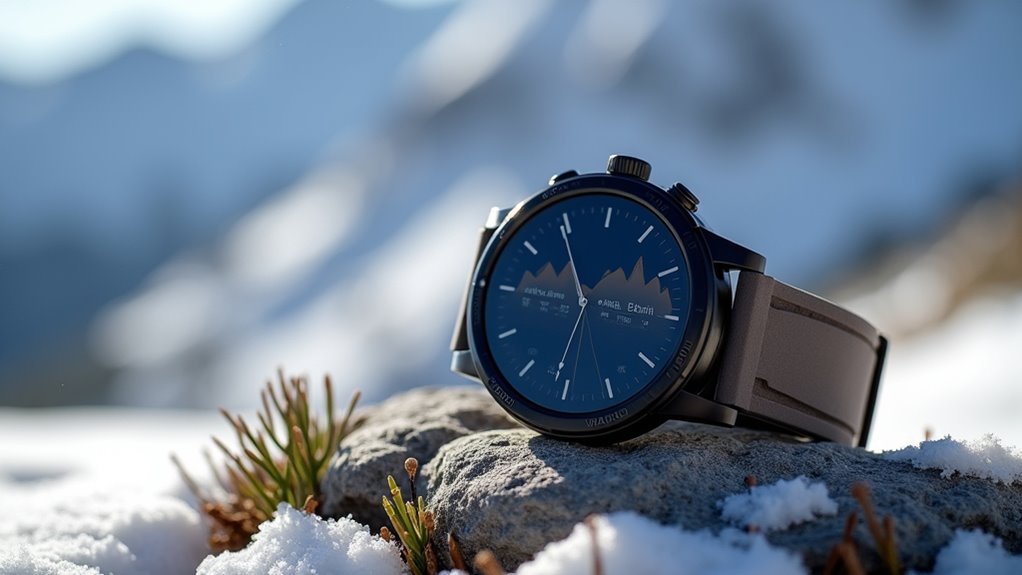
When your watch processes raw elevation data, sophisticated filtering algorithms work behind the scenes to reduce GPS noise and create smoother tracking results.
However, these smoothing algorithms can underestimate both ascent and descent, particularly during steep downhill sections where actual elevation changes get smoothed out.
Your device uses horizontal and vertical filtering techniques, but vertical filtering—crucial for accurate elevation loss detection—isn’t always effective.
Advanced techniques like Kalman filters can fuse data from multiple sensors for better accuracy, though they’re not integrated into all commercial watches.
Firmware limitations restrict calculation precision, while algorithm complexity can lead to over-smoothing.
You typically can’t adjust these filtering settings directly, limiting your ability to optimize tracking for specific downhill activities. Additionally, watches may record data at longer intervals to conserve battery, which can cause the device to miss significant elevation changes during rapid descents.
Environmental Signal Obstruction Effects
Environmental obstacles create a maze of interference that disrupts your watch’s elevation tracking capabilities. Your device struggles when GPS signals can’t reach its receiver clearly, causing significant elevation miscalculations during descents.
Multiple environmental factors conspire against accurate readings:
- Dense foliage and tall buildings block or weaken GPS signals before they reach your watch.
- Mountainous terrain creates signal shadows where satellites can’t penetrate effectively.
- Urban canyons cause signal reflections that confuse your device’s positioning algorithms.
- Weather conditions scatter and delay GPS transmissions, reducing accuracy.
When your watch can’t maintain consistent satellite connections, it compensates by relying more heavily on barometric pressure readings.
However, atmospheric pressure fluctuations from weather fronts further compound elevation errors, making downhill tracking particularly unreliable in challenging environments. Regular calibration of your barometric altimeter becomes essential to maintain accuracy when environmental conditions cause these signal disruptions.
Brand-Specific Elevation Processing Differences
Beyond environmental challenges, the watch brand you choose dramatically affects how accurately it tracks elevation loss. Garmin watches typically deliver the most precise results, often matching true elevation changes within just one foot during testing.
Apple Watch Ultra performs well too, though it may overestimate maximum elevation by 15-24 feet while accurately tracking overall descent. COROS watches show similar patterns with slight maximum elevation discrepancies but reliable range calculations.
Samsung Galaxy Watches struggle most, particularly with minimum elevation readings that can be off by over 200 feet.
The difference lies in sensor technology and processing algorithms. While Garmin and Apple include barometric altimeters with frequent auto-calibration, other brands may rely more heavily on GPS data or use less sophisticated elevation processing methods. Popular fitness brands like Fitbit were excluded from comprehensive testing due to their lack of altimeters.
Threshold Settings for Elevation Change Detection
While your watch’s sensors constantly measure tiny elevation fluctuations, threshold settings determine which changes actually get recorded as meaningful altitude shifts.
These algorithmic filters prevent your device from tracking every minor sensor variation that could distort your elevation data.
Your watch’s threshold implementation affects downhill tracking accuracy in several ways:
- Filters sensor noise from barometric pressure fluctuations and GPS drift
- Ignores trivial changes below your set threshold value
- Reduces mistracking of false elevation loss during descents
- Simplifies data by recording only significant altitude changes
Most devices let you customize these threshold levels based on your activity type and terrain conditions. Wind conditions can also interfere with sensor readings, requiring wind protection for your device during outdoor activities.
However, if your threshold’s set too high, you’ll miss legitimate elevation changes.
Too low, and you’ll record meaningless fluctuations that skew your total elevation loss.
Real-World Performance Limitations and Error Margins
Even when your watch’s threshold settings work perfectly, fundamental limitations in elevation tracking technology create unavoidable error margins that affect downhill measurement accuracy.
Your GPS elevation typically maintains +/-400 feet accuracy with strong signals, but weakens considerably in dense forests or urban canyons where you’re most likely hiking downhill.
Meanwhile, your barometric altimeter can drift 50-75 feet over twelve hours without calibration, and low-pressure weather systems throw readings off markedly. Drastic temperature changes also require recalibration for accuracy since barometric altimeters are not temperature-compensated.
During considerable descents, you’ll often see your watch under-read elevation loss by 200-300 feet due to sensor drift and environmental interference.
However, error margins of 3.3% are generally considered acceptable for most outdoor activities.
Understanding these inherent limitations helps you set realistic expectations for your device’s downhill tracking performance.
Frequently Asked Questions
Can I Manually Adjust My Watch’s Elevation Tracking Sensitivity Settings?
Most watches don’t offer direct elevation sensitivity adjustments. You’ll need to use workaround strategies like manual calibration with known elevations, regular recalibration, and ensuring proper GPS settings for improved tracking accuracy.
Do Expensive Watches Track Downhill Elevation Loss More Accurately Than Budget Models?
Expensive watches typically track downhill elevation loss more accurately because they include barometric altimeters and advanced algorithms. However, you’ll find both budget and expensive models can achieve satisfactory accuracy within reasonable margins.
Should I Wear My Watch on a Specific Wrist for Better Elevation Tracking?
Wear your watch on your non-dominant wrist for steadier sensor readings and reduced motion noise. Consistent placement on one wrist matters more than which specific wrist you choose for elevation tracking.
How Often Should I Replace My Watch to Maintain Elevation Accuracy?
You don’t need to replace your watch solely for elevation accuracy. Regular software updates and recalibration maintain performance. Consider upgrading only when your device malfunctions or becomes considerably outdated.
Can Smartphone Apps Provide More Accurate Downhill Tracking Than Dedicated Watches?
Smartphone apps can match dedicated watches for downhill tracking accuracy, but you’ll get better results if your phone has a barometric altimeter rather than relying solely on GPS elevation data.
In Summary
Your watch’s downhill elevation tracking struggles because it’s fighting multiple measurement challenges simultaneously. You’re dealing with barometric sensors that can’t distinguish between weather changes and actual elevation loss, GPS accuracy limitations in varied terrain, and software algorithms that smooth out data you actually want recorded. Calibration drift, environmental interference, and conservative threshold settings compound these issues. Understanding these limitations helps you interpret your elevation data more realistically during downhill activities.

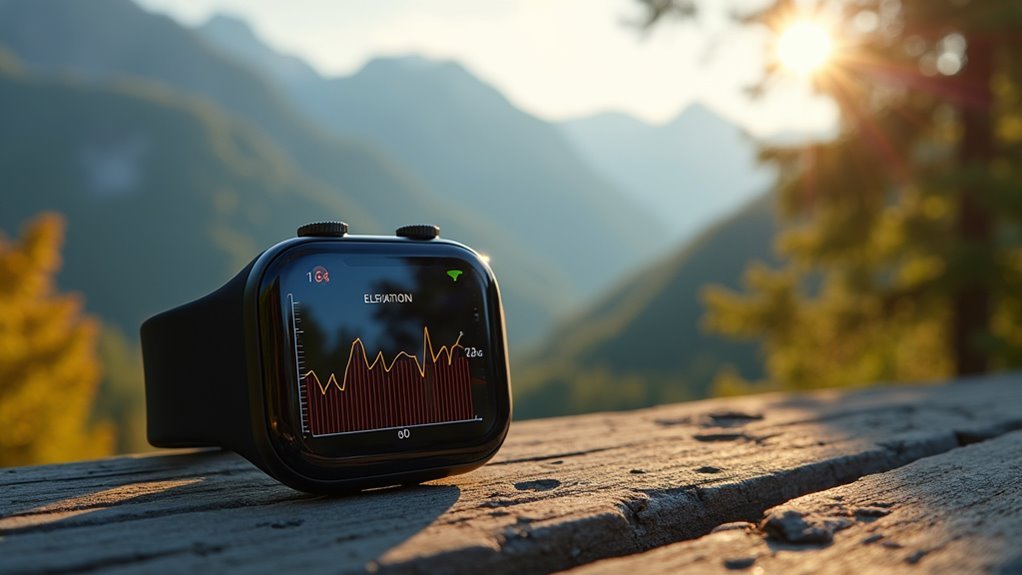
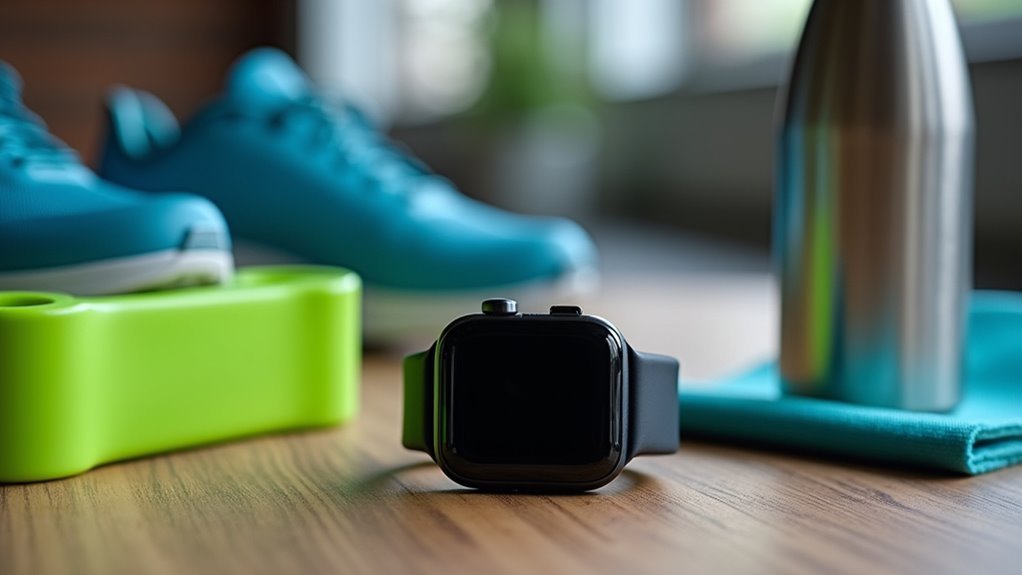
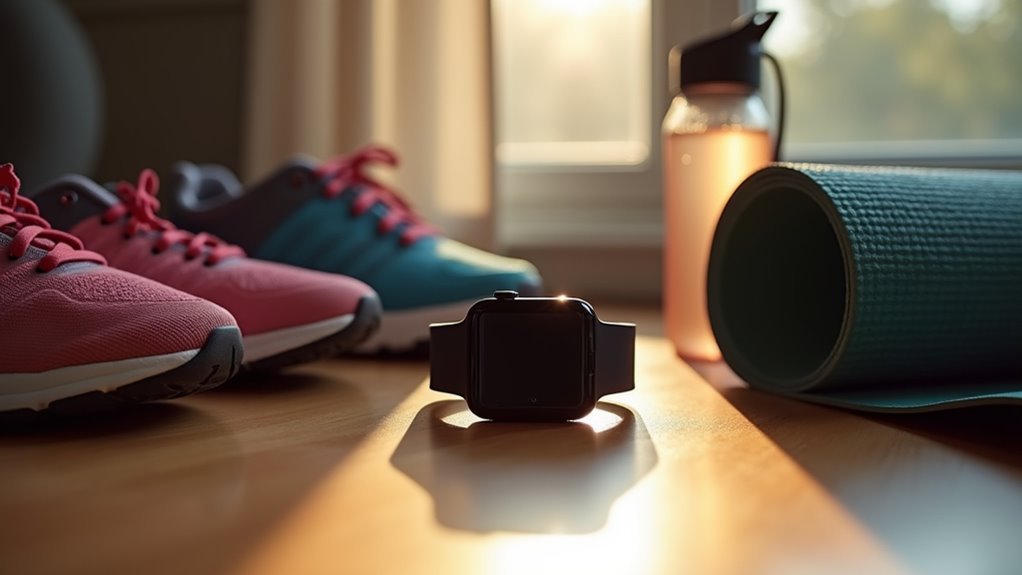
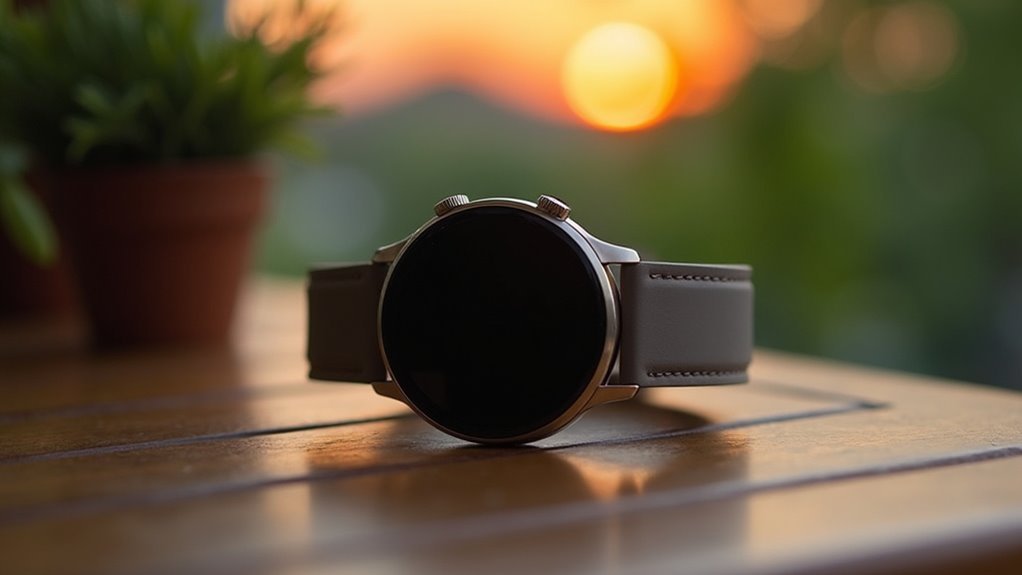
Leave a Reply